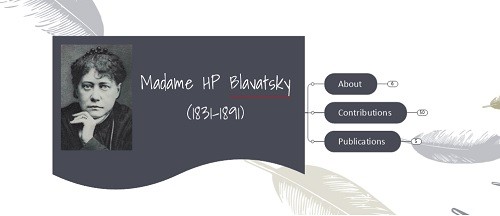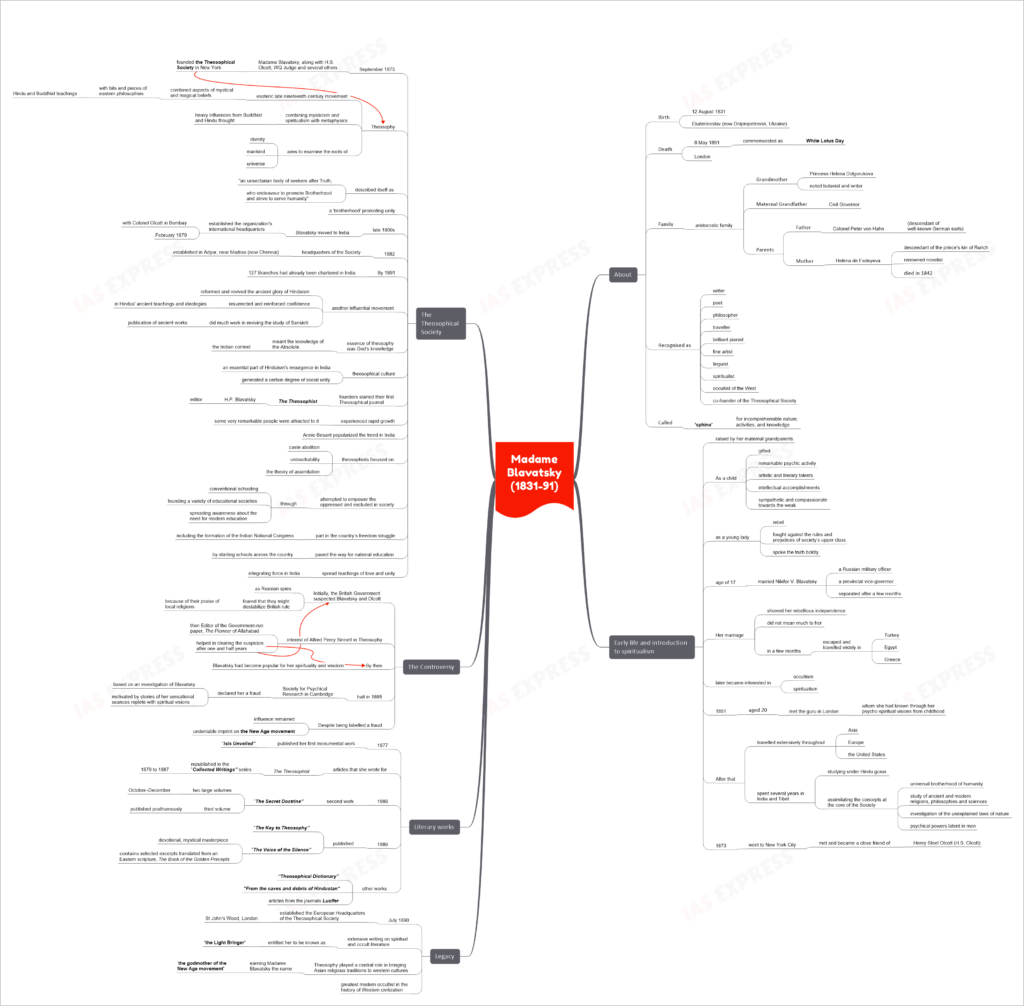Madame HP Blavatsky – Biography, Contributions, Literary Works

Helena Petrovna Blavatskaya popularly known as Madame Blavatsky (1831-91) was a writer, poet, philosopher, traveller, brilliant pianist, fine artist, linguist, spiritualist, occultist of the West and co-founder of the Theosophical Society. She was often called a ‘sphinx’ given her incomprehensible nature, activities, and knowledge. She desired to promote theosophy and had considerable influence over modern spiritual thought. She presented ancient wisdom to the modern age.
Early life and introduction to spiritualism
- Helena Petrovna von Hahn was born at Ekaterinoslav (now Dnipropetrovsk, Ukraine) in an aristocratic family on 12 August 1831.
- Her parents were Colonel Peter von Hahn (descendant of well-known German earls) and Helena de Fadeyeva (descendant of the prince’s kin of Rurich), a renowned novelist.
- Her grandmother Princess Helena Dolgorukova was a noted botanist and writer. After the death of her mother in 1842, Helena was raised by her maternal grandparents (her grandfather was the Civil Governor).
- As a child, Helena was gifted. She displayed remarkable psychic activity, artistic and literary talents, and intellectual accomplishments. Her psychic powers puzzled her family and friends.
- She was sympathetic and compassionate towards the weak. Helena as a young lady was a rebel who fought against the rules and prejudices of society’s upper class. She spoke the truth boldly.
- At the age of 17, Helena Hahn married Nikifor V. Blavatsky, a Russian military officer, and a provincial vice-governor but they separated after a few months.
- Her marriage showed her rebellious independence. It did not mean much to her and in a few months, she escaped and travelled widely in Turkey, Egypt, and Greece, on money supplied by her father.
- She later became interested in occultism and spiritualism.
- In 1851, at the age of 20, Helena met the guru in London whom she said she had known through her psycho-spiritual visions from childhood.
- After that, she travelled extensively throughout Asia, Europe, and the United States; and spent several years in India and Tibet studying under Hindu gurus and assimilating the concepts at the core of the Society: the universal brotherhood of humanity; the study of ancient and modern religions, philosophies and sciences; investigation of the unexplained laws of nature and the psychical powers latent in men.
- In 1873, she went to New York City where she met and became a close friend of Henry Steel Olcott (H.S. Olcott).
The Theosophical Society
- In September 1875, Madame Blavatsky, along with H.S. Olcott, WQ Judge and several others, founded the Theosophical Society in New York.
- Theosophy was an esoteric late nineteenth-century movement that combined aspects of mystical and magical beliefs with bits and pieces of eastern philosophies bound up in Hindu and Buddhist teachings.
- It is a philosophy combining mysticism and spiritualism (with heavy influences from Buddhist and Hindu thought) with metaphysics.
- Theosophy aims to examine the roots of divinity, mankind, and the universe.
- The society described itself as “an unsectarian body of seekers after Truth, who endeavour to promote Brotherhood and strive to serve humanity”. “The Society was fashioned as a ‘brotherhood’ promoting unity.
- In the late 1800s, Madame Blavatsky moved to India and established the organization’s international headquarters, with Colonel Olcott in Bombay in February 1879.
- In 1882, the headquarters of the Society were established in Adyar, near Madras (now Chennai) in India. By 1891, 127 Branches had already been chartered in India.
- The Theosophical Society was another influential movement which reformed and revived the ancient glory of Hinduism.
- The essence of theosophy was God’s knowledge. In the Indian context, it meant the knowledge of the Absolute.
- The theosophical culture was an essential part of Hinduism’s resurgence in India and generated a certain degree of social unity. The movement resurrected and reinforced confidence in Hindus’ ancient teachings and ideologies.
- It also did much work in reviving the study of Sanskrit and the publication of ancient works.
- The founders started their first Theosophical journal, The Theosophist, with H.P. Blavatsky as editor.
- The Theosophical Society experienced rapid growth, and some very remarkable people were attracted to it, both in India and abroad.
- Annie Besant popularized the trend in India. The theosophists focused on caste abolition, untouchability, and the theory of assimilation.
- It also attempted to empower the oppressed and excluded in society through conventional schooling, founding a variety of educational societies and spreading awareness about the need for modern education.
- The Theosophical Society had a part in the country’s freedom struggle, including the formation of the Indian National Congress.
- The Theosophical Society paved the way for national education by starting schools across the country.
- The Theosophical Society, spreading teachings of love and unity, acted as an integrating force in this multilingual, multi-racial and religious nation.
The controversy
- Initially, the British Government suspected Blavatsky and Olcott of being Russian spies. The colonial authorities feared that they might destabilize British rule because they praised local religions.
- However, it was the interest of Alfred Percy Sinnett in Theosophy, then Editor of the Government-run paper, The Pioneer of Allahabad, which helped in clearing the suspicion after one and half years.
- By then, Madame Blavatsky had become popular for her spirituality and wisdom.
- However, this halted in 1885, when the Society for Psychical Research in Cambridge declared her a fraud.
- It was based on an investigation of Blavatsky and motivated by stories of her sensational seances replete with spiritual visions.
- Despite being labelled a fraud, Blavatsky’s influence remained and her imprint on what later became the New Age movement is undeniable.
Literary works
- In 1877, Madame Blavatsky published her first monumental work, “Isis Unveiled”.
- The articles that she wrote for the journal, The Theosophist were republished in the “Collected Writings” series from 1879 to 1887.
- In 1888, her second work “The Secret Doctrine” was published in two large volumes in October–December. The third volume was published posthumously.
- In 1889, Madam Blavatsky published “The Key to Theosophy” and the devotional, mystical masterpiece called “The Voice of the Silence”, containing selected excerpts translated from an Eastern scripture, The Book of the Golden Precepts.
- Her other works include “Theosophical Dictionary”, “From the caves and debris of Hindustan”, and articles from the journals Lucifer and others.
Death and legacy
- In July 1890, Madame Blavatsky established the European Headquarters of the Theosophical Society at St John’s Wood, London.
- She died on 8 May 1891 in London. This date is commemorated as White Lotus Day.
- Her extensive writing on spiritual and occult literature entitled her to be known as ‘the Light Bringer.’
- Theosophy played a central role in bringing Asian religious traditions to western cultures earning Madame Blavatsky the name, ‘the godmother of the New Age movement.’
- She has been the greatest modern occultist in the history of Western civilization.


